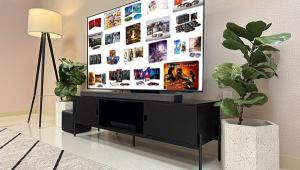Panasonic TH-50PX600U High-definition Plasma TV Tests and Calibration
Overscan was as excellent as one would expect from a plasma panel, not measuring more than 4% anywhere on screen at any resolution via component or HDMI. Lines were straight and true but there was some color fringing in the neighborhood of a pixel in width in some areas of the screen.

Many if not most displays now allow user-level access to the controls needed to calibrate a grayscale properly. Panasonic's plasmas are still in the dark ages, requiring not only service level adjustments, but defaulting to less than desirable picture modes when the adjustments are made. Worse, the readings made in the service mode changed slightly when the measurements were repeated after I dropped out of it and retuned to normal operation. This required a tedious process of entering the service menu, making an adjustment, taking a reading, dropping out of the service mode, checking how that reading changed, and repeating the process as I zeroed in on the desired result.
Nevertheless, the out of box performance of the Warm color temperature was quite acceptable in terms of color temperature- overall, this set needs an ISF work over less than many other flat panels do. The biggest thing I was able to accomplish during calibration was to dial in closer to the actual D65 target. While my calibration ended up a bit high-ish in the low end, it dialed in reasonably tight throughout the rest of the range and the subjective color balance was more pleasing than it was out-of-the-box. Note that I'll live with color temperature numbers that aren't spot-on in order to eliminate any color tint toward green, which is far more noticeable to the eye. This is acceptable, but not perfect performance. Keep in mind that had I more time to go back and forth between the service mode and user mode making small adjustments, as described earlier, I could have done even better.
Far more problematic to me was the complete washing out of high frequency information with 1080i HD signals from my AccuPel test generator with HDMI. There was nothing but a gray band where the single pixel width areas of the luma and chroma bursts should be, which represent the 37.1MHz threshold of 1080i HD. Worse, even the double pixel wide areas of the burst looked more banded and ragged than usual, suggesting seriously compromised HD resolution at 1080i. 720p looked much better, with strong resolution at 37.1MHz, suggesting that if your HD set-top box offers you the choice you might get a better picture using 720p instead of 1080i—depending of course on the quality of your set-top 's deinterlacer/scaler. 1080i bursts via component video didn't do any better at 37.1MHz, but was better at 18.5MHz (double pixel width bursts) and also had better chroma response. And 720p component looked better still with strong resolution out to 37.1MHz, but with some slight banding. 480i and 480p were strong out to their frequency limits.
Since Joel used component video during his evaluations I'm surprised the set didn't perform a bit better, at least with DVD signals. However, I would note that I concur with Joel on the poor quality of the Comcast cable HD signals I saw there, and I'd also note that Sony's DVD players, past and present, tend to be a little softer and more natural looking. The characteristics of both sources are not complimentary to this set's shortcomings.—Shane Buettner













































